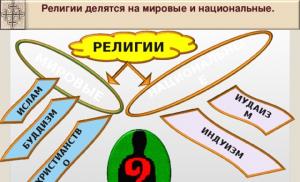World religions. Faith takes many different forms, and these forms are called religion.
Target: study of religious (confessional) structure, formation of religious tolerance
Tasks: identify similarities and differences in religions, introduce them to the religious traditions of Orthodoxy, Islam, Buddhism, and continue the formation of independent work with literature.
Equipment: map of world religions, multimedia projector, computer with software, notebooks, textbooks, rosary, crosses.
Students are divided in advance into groups with an advanced task: to make presentations on world religions according to a rough plan:
From the history of religion
Countries with the greatest spread of religion, approximate number of followers
Branches, directions of religions
Features of the doctrine
Features of religious life
buildings for prayer,
symbols of faith,
attributes,
religious etiquette,
holidays, fasts, days of rest,
religious art
marriage, family, attitude towards death, mourning
interesting facts (parables)
Learning new material
Teacher. Studying the traditions, customs and culture of the peoples of the world, we cannot help but talk about religions. There are practically no people on Earth without religion, just as there are no people without language and culture. Religion has had and continues to have a great influence on the social life of many countries and peoples. It plays a very important role in a person’s personal life, determines his demographic behavior, and shapes moral standards and people’s worldview. Religion can act as an ethnic-forming factor and a national characteristic. To this day, religion also remains an important political instrument.
Let's remember what religion is (students' answer).
Religion is a worldview, attitude, as well as corresponding behavior determined by faith in the existence of God, a deity. It determines a person’s relationship to the sacred.
People who profess any religion believe in the spiritual world and have approximately the same ideas about life and death
There are many religions in the world. Each has its own traditions, customs, and rules that its followers must observe.
Name the world religions (students’ answer).
Buddhism is one of the world religions (along with Christianity and Islam), which arose in the 6th century. BC e. in India and named after its founder Gautama, who later received the name Buddha (enlightened, clairvoyant). Buddhism became widespread in China, Japan, Tibet, Mongolia and other Eastern countries. In Russia, Buddhism is traditionally practiced by Buryats, Tuvans and Kalmyks.
Christianity- one of the three world religions (along with Islam and Buddhism), which arose in the 1st century. n. e., consists of three main branches - Catholicism, Orthodoxy, Protestantism, united by faith in Christ
Islam(Muslim) - one of the three world religions along with Christianity and Buddhism, which arose at the beginning of the 7th century. and widespread mainly in Asia and Africa (the youngest of the world's religions).
In addition to world religions, there are national religions, for example in China - Confucianism, in India - Hinduism, in Japan - Shintoism, Judaism is professed by a separate people - Jews. Local traditional religions – shamanism(belief in the ability of individuals to communicate with spirits and use this connection for healing, making rain, etc.), fetishism(belief in an inanimate material object to which supernatural properties are attributed), animism(belief in the soul not only of people, but also of animals, plants, cult of ancestors or the dead) totemism and others. They are followed by some peoples in Southeast Asia, Australia and Oceania, Tropical and East Africa.
Our guests are representatives of various religions. They will talk about the peculiarities of religions.
To make it easier to remember, understand and assimilate today’s material, we will fill out the table in pairs as our guests tell their story (the table is checked)
Student performance using presentations.
Christianity
Confucianism
Consolidation of the entered material
Name the world religions
What other religions exist besides the world ones?
Do you think superstition and religion are the same thing? Justify your answer
How similar or different do you think the ethical teachings of Buddhism and Christianity are?
In Buddhism, is there an omnipotent creator God or a personal God, an eternal soul.
What are the names of the holy books in Buddhism, among Muslims, the main source of doctrine for Christians?
Does Islam allow terrorist attacks, what is jihad?
Prophet Muhammad - who is he, tell us about him.
What is the date of the emergence of Islam?
Compare the principles of the teachings of different religions. Let's watch the presentation.
Who are Moses and Jesus Christ? Name the religions.
Name the days of rest for Muslims, Christians, and Jews.
Name the most memorable features of religions.
What religious buildings are there in our city?
What types of religions are practiced here?
Lesson summary
Conclusion:
Unlike monotheistic religions (Judaism, Christianity, Islam), in Buddhism there is neither an omnipotent creator God nor a personal God, nor an eternal soul. There is also no concept of “many gods” in Buddhism. These same provisions and the denial of the caste system distinguishes Buddhism from Hinduism and Brahmanism, although it recognizes the doctrine of karma.
Despite the different religions of the peoples of the world, not a single religion in the world calls for war or terrorism. Having become acquainted with the traditions and customs of the peoples of the world, having understood them, we learn to understand and respect their worldviews.
The grade for the lesson is given to students who prepared presentations and actively answered questions.
Literature
1. Alekseev A.I., Nikolina V.V., Bolysov S.I. Geography. Countries and continents.. 7th grade: textbook. for general education institutions; Ross. acad. Sciences, Ross. acad. education, publishing house "Enlightenment". – 3rd ed. – M.: Enlightenment. 2010.- 255 pp.: ill., map. – (Academic school textbook) (Polar Star).
2. Kulakov A.E. History of religions in Russia: methodological support. Lectures 1-4 – M.: Pedagogical University “First of September”, 2010 – 88 p.
3. Kulakov A.E. History of religions in Russia: methodological support. Lectures 5-8 – M.: Pedagogical University “First of September”, 2010 – 112 p.
HOW RELIGIONS Arose. RELIGIONS OF THE WORLD AND THEIR FOUNDERS.
Teacher of history and social studies of the Zlatopol secondary school, Burabay district, Akmola region Omarov B.E.

Religions are divided into world and national.
WORLD
NATIONAL
CHRISTIANITY
ISLAM
HINDUISM
JUDAISM
RELIGIONS

MOSES- Jewish prophet, king, commander and legislator, founder of Judaism, who united the Israeli people.
Through Moses, God communicated his law to the Jews.
Moses with the tablets.
Rembrandt, 1659

In the Old Testament, God promised people to send the Messiah to earth - the Savior of the world, the Only Begotten Son of God, the Lord Jesus Christ.
The fulfillment of this promise is called the New Covenant.
CHRISTIANITY

Time of origin - 1st century BC.
Place of origin: Palestine
The founder of the religion is Jesus Christ of Nazareth.
The world's largest religion in terms of number of followers.
CHRISTIANITY

Jesus Christ , Having appeared on earth, having defeated sin and death on the Cross, he entered into a new alliance or agreement with people.
Christianity- teaching about the life and resurrection of Christ.
Christians– followers of Jesus
CHRISTIANITY


Religions of the world and their founders
Orthodox culture
islamic culture
Buddhist culture
Jewish culture
Jesus
Christ
Moses
Muhammad
Buddha

- Page 13: Read the text “Islam”.
- Islam (Arabic for "submission")
- What was the name of the founder of Islam?
- Which city is considered holy for Muslims?
- What did Muhammad call for?
- MUSLIMS –
followers
Muhammad

- Origin: 7th century AD
- Place of origin: Arabian Peninsula
- Founder of the religion - Muhammad

View of a Muslim mosque

- Time of origin: 6th century BC.
- Place of origin - India

- Page 14-15 read.
- Why did Siddhartha Gautama leave his palace?
- What does the word Buddha mean?


Truths:
- There is suffering in the world
- There is a cause of suffering - desire
- There is liberation from suffering - nirvana
- There is a path leading to liberation from suffering.

BUDDHIST TEMPLE
Palace Temple in Bangkok
Buddha's Enlightenment Site

Why do you think Christianity, Islam and Buddhism became world religions?
What can you tell your family and friends about the origins of world religions?
What do you remember most from the text you read and what was said in class?
Homework: Tell us at home what you learned in class.
Ask your elders to tell you what they know that is interesting and important about this or that religion?

Slide 1
World religions

Slide 2
Nowadays, there are a great many religions, but each person chooses for himself the one that he considers the most correct and which is closest to him in perception and beliefs.

Slide 4
Statistics

Slide 5
Buddhism is a philosophy built on the teachings of Buddha. Gautama Buddha was born within the present eastern border of Nepal. He spent his entire life in India and devoted it to the philosophy of existence. His parables were based on the suffering of Samsara (one of the basic concepts in Buddhism, meaning birth and death). One of the most important symbols of Indian philosophy is the soul. The soul is drowning in the “waters of Samsara”, trying to get rid of its past mistakes and cleanse itself. Millions of people in Asia, as well as other parts of the world, practice Buddhism.

Slide 6
Islam "Islam" means "submission to God" and is a religion based on the teachings of Muhammad. The holy book Koran was revealed to the Prophet Muhammad by Allah. Followers of Islam are known as Muslims. They adhere to the five basic principles of Islam, the five rules on which the faith of a true Muslim is based (monotheism, five times daily prayer, charity, fasting during the month of Ramadan, pilgrimage to Mecca). There are more than 1 billion Muslims worldwide, making it the second largest religion after Christianity.

Slide 7
Christianity is a religion whose geography is the most extensive. The teachings of Jesus Christ formed the basis of this religion, hence the name “Christianity”. Christians believe that Jesus is the son of God and believe in the Trinity (God the Father, God the Son and God the Holy Spirit). The Bible says that Jesus will return to earth to judge the living and the dead. The Bible is the holy book of Christians; it consists of two parts: the Old Testament and the New Testament. The Old Testament describes life before the birth of Jesus Christ, while the New Testament describes the life and teachings of Jesus himself. There are more than two billion followers of Christianity in the world.

Slide 8
Today in Christianity there are the following main directions:

Faith takes many different forms, and these forms are called religion. Religion (from Latin religio - connection) is the worldview and behavior of people based on belief in the existence of one or many gods. The idea of the existence of God is the central point of the religious worldview. In Hinduism, for example, there are thousands of gods, in Judaism - one, but the basis of both religions is faith. Religious consciousness comes from the belief that, along with the real world, there is another - a higher, supernatural, sacred world. And this allows us to assume that the external diversity and diversity of cults, rituals, and philosophies of numerous religious systems are based on some common ideological ideas.

Buddhism is the oldest of the world's religions, which received its name from the name, or rather from the honorary title, of its founder Buddha, which means Enlightened One. Buddha Shakyamuni (a sage from the Shakya tribe) lived in India in the V-IV centuries. BC e. Other world religions - Christianity and Islam - appeared later (five and twelve centuries later, respectively). If we try to imagine this religion from a bird’s eye view, we will see a motley patchwork quilt of trends, schools, sects, subsects, religious parties and organizations. Buddhism has absorbed many diverse traditions of the peoples of those countries that fell into its sphere of influence, and also determined the way of life and thoughts of millions of people in these countries. Most adherents of Buddhism now live in South, Southeast, Central and East Asia: Sri Lanka, India, Nepal, Bhutan, China, Mongolia, Korea, Vietnam, Japan, Cambodia, Myanmar (formerly Burma), Thailand and Laos. In Russia, Buddhism is traditionally practiced by Buryats, Kalmyks and Tuvans.

Buddhists themselves count down the existence of their religion from the death of the Buddha, but among them there is no consensus about the years of his life. According to the tradition of the oldest Buddhist school - Theravada, Buddha lived from 6 24 to 544 BC. e. According to the scientific version, the life of the founder of Buddhism is from 566 to 486 BC. e. Some areas of Buddhism adhere to later dates: gg. BC e. The birthplace of Buddhism is India (more precisely, the Ganges Valley). The society of Ancient India was divided into varnas (classes): brahmans (the highest class of spiritual mentors and priests), kshatriyas (warriors), vaishyas (merchants) and sudras (serving all other classes). Buddhism for the first time addressed a person not as a representative of any class, clan, tribe or a certain gender, but as an individual (unlike the followers of Brahmanism, the Buddha believed that women, on an equal basis with men, are capable of achieving the highest spiritual perfection). For Buddhism, only personal merit was important in a person. So, the word brahman Buddha calls any noble and wise person, regardless of his origin.

According to legends, the future Buddha was reborn a total of 550 times (83 times as a saint, a king, a monk, a monkey, a merchant, a chicken, 8 times as a goose, 6 times as an elephant; in addition, a fish, a rat, a carpenter, a blacksmith, a frog, hare, etc.). This was until the gods decided that the time had come for him, born in the guise of a man, to save the world, mired in the darkness of ignorance. The birth of Buddha into a kshatriya family was his last birth. That is why he was called Siddhartha (He who has achieved the goal). The boy was born with thirty-two signs of a great husband (golden skin, a wheel sign on the foot, wide heels, a light circle of hair between the eyebrows, long fingers, long earlobes, etc.). A wandering ascetic astrologer predicted that a great future awaited him in one of two spheres: either he would become a powerful ruler, capable of establishing righteous order on earth, or he would be a great hermit. The father did everything possible to prevent the prediction from coming true: he surrounded his son with wonderful things, beautiful and carefree people, and created an atmosphere of eternal celebration so that he would never know about the sorrows of this world. Siddhartha grew up, got married at the age of 16, and had a son, Rahula. But the father's efforts were in vain. With the help of his servant, the prince managed to secretly escape from the palace three times.

For the first time he met a sick person and realized that beauty is not eternal and there are ailments in the world that disfigure a person. The second time he saw the old man and realized that youth is not eternal. For the third time he watched a funeral procession, which showed him the fragility of human life. When the prince decided on the great renunciation, he was 29 years old. After six years of ascetic practice and another unsuccessful attempt to achieve higher insight through fasting, he was convinced that the path of self-torture would not lead to the truth. Then, having regained his strength, he found a secluded place on the river bank, sat down under a tree (which from that time on was called the Bodhi tree, i.e., the tree of Enlightenment) and plunged into contemplation. Before Siddhartha's inner gaze, his own past lives, the past, future and present lives of all living beings passed, and then the highest truth - Dharma - was revealed. From that moment on, he became the Buddha - the Enlightened One, or the Awakened One - and decided to teach the Dharma to all people who seek truth, regardless of their origin, class, language, gender, age, character, temperament and mental abilities.

Unlike other world religions, the number of worlds in Buddhism is almost infinite. Buddhist texts say that they are more numerous than drops in the ocean or grains of sand in the Ganges. Each of the worlds has its own land, ocean, air, many heavens where the gods live, and levels of hell inhabited by demons, spirits of evil ancestors - pretas, etc. In the center of the world stands the huge Mount Meru, surrounded by seven mountain ranges. At the top of the mountain there is a sky of 33 gods, headed by the god Sakra. In Buddhism, unlike Christianity and Islam, there is no church, but there is a community of believers - the sangha. This is a spiritual brotherhood that helps in progress along the Buddhist path. The community provides its members with strict discipline (wine) and the guidance of experienced mentors.


Christianity (from the Greek christos - “anointed one”, “Messiah”) is the second oldest of the world religions. It originated as one of the sects of Judaism in the 1st century. AD in Palestine. This original relationship with Judaism - extremely important for understanding the roots of the Christian faith - is also manifested in the fact that the first part of the Bible, the Old Testament, is the sacred book of both Jews and Christians (the second part of the Bible, the New Testament, is recognized only by Christians and is for the most important of them). The New Testament consists of: four Gospels (from the Greek - “gospel”) - “Gospel of Mark”, “Gospel of Luke”, “Gospel of John”, “Gospel of Matthew”, Epistles of the Apostles (letters to various Christian communities) - 14 of these Epistles are attributed to the Apostle Paul, 7 to other apostles, and the Apocalypse, or Revelation of John the Theologian, in the Bible. - M.: Russian Bible Society Publishing House, 2000. The Church considers all these teachings to be divinely inspired, that is, written by people at the inspiration of the Holy Spirit. Therefore, a Christian should respect their content as the highest truth.

The basis of Christianity is the opinion that after the Fall, people themselves could not return to communion with God. Now only God himself could come out to meet them. The Lord goes out in search of a person to return himself to us. Christ, the son of God, born through the Holy Spirit from the earthly girl Mary (the Mother of God), the God-man, took upon himself not only all the hardships of human life, having lived among people for 33 years. To atone for human sins, Jesus Christ voluntarily accepted death on the cross, was buried and rose again on the third day, foreshadowing the future resurrection of all Christians. Christ took upon Himself the consequences of human sins; Christ filled that aura of death with which people surrounded themselves, isolating themselves from God. Man, according to Christian teaching, was created as a bearer of the “image and likeness” of God. However, the Fall committed by the first people destroyed man's godlikeness, placing on him the stain of original sin.

Christ, having suffered on the cross and death, “redeemed” people, suffering for the entire human race. Therefore, Christianity emphasizes the cleansing role of suffering, any limitation by a person of his desires and passions: “by accepting his cross,” a person can overcome evil in himself and in the world around him. Thus, a person not only fulfills God’s commandments, but also transforms himself and ascends to God, becoming closer to him. This is the purpose of the Christian, his justification of the sacrificial death of Christ. Connected with this view of man is the concept of sacrament, characteristic only of Christianity - a special cult action designed to really introduce the divine into human life. This is, first of all, baptism, communion, confession (repentance), marriage, unction.

Spreading among the Jews of Palestine and the Mediterranean, Christianity already in the first decades of its existence won adherents among other peoples. Even then, the universalism inherent in Christianity was revealed: communities scattered across the vast expanse of the Roman Empire nevertheless felt their unity. People of different nationalities became members of the communities. The New Testament thesis “there is neither Greek nor Jew” proclaimed the equality before God of all believers and predetermined the further development of Christianity as a world religion that knows no national and linguistic boundaries. Christianity is a religion of redemption and salvation. Unlike religions where God is seen as a formidable Master (Judaism, Islam), Christians believe in God's merciful love for sinful humanity.

Christianity is the most widespread religion on the globe (about a million people in the modern world are Christians). It distinguishes three main movements: Catholicism, Orthodoxy and Protestantism.


The third (latest in time of origin) world religion is Islam, or Islam. It is one of the most widespread religions: there are about 900 million adherents, mainly in North Africa, South-West, South and Southeast Asia. Arabic-speaking peoples almost entirely profess Islam, Turkic-speaking and Iranian-speaking peoples - in the overwhelming majority. There are also many Muslims among the North Indian peoples. The population of Indonesia is almost entirely Muslim.

Islam originated in Arabia in the 7th century AD. e. Its origin is clearer than the origin of Christianity and Buddhism, for it is illuminated by written sources almost from the very beginning. But there is a lot of legendary stuff here too. According to Muslim tradition, the founder of Islam was the prophet of God Muhammad (Magomed), an Arab who lived in Mecca; he allegedly received from God a number of “revelations” recorded in the holy book of the Koran, and conveyed them to people. The Koran is the main holy book of Muslims, like the Pentateuch of Moses for Jews and the Gospel for Christians.

Muhammad himself did not write anything, but after him there remained scattered records of his sayings and teachings, made at different times. Texts from both earlier and later times are attributed to Muhammad. Around 650 (under Muhammad's third successor, Osman), a code was compiled from these records, called the Koran ("reading"). This book was declared sacred, dictated to the prophet himself by Archangel Jebrail; records not included in it were destroyed.

The Koran is divided into 114 chapters (surahs). They are arranged simply by size: the longer ones are closer to the beginning, the shorter ones are towards the end. The Meccan (earlier) and Medina (later) suras are mixed. The same thing is repeated verbatim in different suras. Exclamations and glorifications of the greatness and power of Allah alternate with instructions, prohibitions and threats of “gehenna” in the future life to all disobedient people. In the Koran there are no traces of such editorial and literary finishing; these are completely raw texts from primary sources.

The dogma of Islam is very simple. A Muslim must firmly believe that there is only one god - Allah; that Muhammad was his messenger-prophet; that before him, God sent other prophets to people - these are the biblical Adam, Noah, Abraham, Moses, Christian Jesus, but Muhammad is higher than them; that there are angels and evil spirits (jinn), however, these latter, who converted to Islam from ancient Arabic beliefs, are not always evil, they are also in the power of God and carry out his will; that on the last day of the world the dead will rise and everyone will receive rewards for their deeds: the righteous who honor God will enjoy in paradise, sinners and infidels will burn in hell; finally, that there is divine predestination, for Allah has predetermined each person’s destiny.

Different ideas about God are inextricably linked with different views of man. In Christianity, man is created “in the image and likeness of God,” but Adam’s original sin “damaged” human nature—“damaged” it so much that God’s atoning sacrifice was required. Islam has different ideas about man. He is not conceived of as created in the image and likeness of God, but he does not experience such a grandiose fall. The person is weak rather than “damaged.” Therefore, he does not need atonement from sins, but the help and guidance of God, who shows him the right path in the Koran.

Different systems of ideas about a person also imply differences in ethical values. Faith in Christianity is inextricably linked with love for God, who loved man so much that for his sake he endured the agony of the cross. Islam also involves faith, but it is a slightly different faith. Faith here is not faith in the paradox of a crucified God, not separable from love for him, but submission to the instructions of Allah given through the prophet in the Koran. The nature of Islam predetermines the penetration of the religious model of the world into the very fabric of the socio-political life of Muslims. These are the main features of the three world religions: Buddhism, Christianity and Islam.


Slide 2
Nowadays, there are a great many religions, but each person chooses for himself the one that he considers the most correct and which is closest to him in perception and beliefs.
Slide 3
- Buddhism;
- Islam;
- Christianity.
Slide 4
Statistics
Slide 5
Buddhism
Buddhism is a philosophy built on the teachings of Buddha. Gautama Buddha was born within the present eastern border of Nepal. He spent his entire life in India and devoted it to the philosophy of existence. His parables were based on the suffering of Samsara (one of the basic concepts in Buddhism, meaning birth and death). One of the most important symbols of Indian philosophy is the soul. The soul is drowning in the “waters of Samsara”, trying to get rid of its past mistakes and cleanse itself. Millions of people in Asia, as well as other parts of the world, practice Buddhism.
Slide 6
Islam
"Islam" means "submission to God" and is a religion based on the teachings of Muhammad. The holy book Koran was revealed to the Prophet Muhammad by Allah. Followers of Islam are known as Muslims. They adhere to the five basic principles of Islam, the five rules on which the faith of a true Muslim is based (monotheism, five times daily prayer, charity, fasting during the month of Ramadan, pilgrimage to Mecca). There are more than 1 billion Muslims worldwide, making it the second largest religion after Christianity.
Slide 7
Christianity
Christianity is a religion whose geography is the most extensive. The teachings of Jesus Christ formed the basis of this religion, hence the name “Christianity”. Christians believe that Jesus is the son of God and believe in the Trinity (God the Father, God the Son and God the Holy Spirit). The Bible says that Jesus will return to earth to judge the living and the dead. The Bible is the holy book of Christians; it consists of two parts: the Old Testament and the New Testament. The Old Testament describes life before the birth of Jesus Christ, while the New Testament describes the life and teachings of Jesus himself. There are more than two billion followers of Christianity in the world.













